If you are interested in lifting weights, you may have heard the term PPL, a training split that’s often recommended to build strength and muscle. PPL is an acronym for the body part training split consisting of push, pull, and leg days. We’ve previously covered push day workout, which brings us to the next part of the PPL workout sequence — pull days.
Much like a push day, a pull day consists of upper body exercises, but in contrast to the former which trains the chest, front shoulders, and triceps, pull day exercises mainly trains the back muscles and biceps.
In this article, we’ll go over our favorite pull-day routine, which consists of the following exercises: Pendlay/barbell rows, chin-ups, seated cable rows, lat pull-downs, bent-over dumbbell flyes, preacher curls, and concentration curls. We will also share some information on how to get the most out of your pull days, including guidance for maximum results, safety precautions to follow, as well as tips for nutritional planning and progress tracking.
What is a Pull Day?
A pull day includes exercises that train the muscles of the back and biceps. While all muscles technically “pull”, bringing the origin and insertion closer to one another during concentric (muscle-shortening) contractions, the human skeleton is arranged in such a way that some muscles’ shortening results in “pushing” motions and others result in “pulling” motions. For example, the triceps muscles are considered push muscles, but when they contract and shorten, they pull on the ulna to extend the elbow. The biceps also pull on the ulna during a concentric contraction, but from the opposite side compared to the triceps, which results in elbow flexion. Overall, the muscles trained during a pull day work the muscles in our upper bodies that allow us to perform pulling, curling, and rowing motions.
A pull day typically entails doing some compound movements such as bent-over rows or chin-ups, as well as isolation exercises like biceps curls to directly target the muscles that usually act as synergists in a pulling motion of the upper body. Working the posterior or backside of the upper body requires pulling a load towards the torso, as opposed to training the front upper body muscles, such as the chest and anterior deltoid, which are activated by pushing a load away from the body. Training these muscles is important for building strength and size, and has similar benefits to resistance training in general, such as reduced sensitivity to pain, increased energy levels, and better sleep quality. [1]
Pull days are generally implemented as a part of a PPL routine, though there are other variations of body part splits that pair training muscles of the back and biceps together. Still, the PPL split is a very popular way to organize training, as they are very flexible to different preferred training frequencies, e.g. 3x/wk or 6x/wk. Hitting each muscle group twice per week may improve hypertrophy results, as this increases total training volume. [2]
PPL splits are also relatively easy to program. The formula is simple: do pushing movements on one day, pulling movements on the other, and leg exercises on the last day. Taking this approach to planning would mean that you wouldn’t have to think about specific muscles while putting together your workout. Planning according to the nature of the movements (is it a pushing or a pulling movement?) is just as effective, and following a PPL workout routine would allow you to train the whole body without the hassle of trying to figure out which exercises to do based on targeted muscle groups.
So, now that we’ve covered what a pull day is, how it fits into a PPL routine as well as some benefits of following a PPL routine, let’s talk a bit about muscular anatomy.
What are the Muscles Worked in a Pull Day Workout?
The muscles engaged in a pull-day workout are as follows;
- The latissimus dorsi
- The trapezius
- The posterior deltoid, or rear delts
- The rhomboids
- The lower back muscles — including the erector spinae, quadratus lumborum, multifidus, and others
- The biceps brachii
- The brachialis
- The forearm muscles
What is the Best Pull Day Workout Routine & Exercises?
Here are the exercises we’ve selected for the ultimate pull-day workout:
- Pendlay/Barbell rows: 3 to 4 sets of 5 to 8 repetitions
- Chin-ups: 3 to 4 sets of 5 to 8 repetitions
- Seated cable rows: 2-4 sets of 6-10 repetitions
- Lat pull-downs: 2-4 sets of 8 to 12 repetitions
- Bent-over dumbbell flyes: 2 to 4 sets of 10 to 15 repetitions
- Preacher curls: 3 to 5 sets of 8 to 12 repetitions
- Concentration curls: 3-5 sets of 10 to 15 repetitions
1. Pendlay Row/Barbell Row
The Pendlay row or barbell row is the bench press of the back muscles. It’s a compound movement that trains the majority of muscles of the back in the horizontal plane. Apart from working the biceps brachii, latissimus dorsi, and posterior deltoid, the Pendlay row also activates the rhomboids, glutes, and hamstrings.
Not only is the Pendlay row an effective compound exercise that can engage muscles in both the upper and lower body, but it could also benefit individuals who are experiencing pain in their backs.
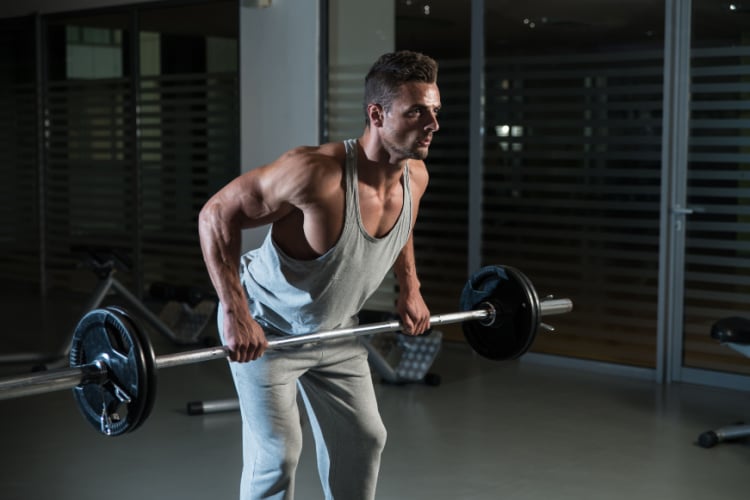
Movement Category: Primary
Programming: 3 to 4 sets of 5 to 8 repetitions
Weight: Use a weight that leaves you 2 to 3 repetitions short of failure, e.g. RPE 7 to 8.
To do a Pendlay row:
- Load a barbell.
- Take a stance similar to what you would use for a deadlift, e.g. your feet approximately distance apart. Your shins should be ~ 1” from the barbell when standing up straight.
- With a soft bend in your knees, bend over or hinge at the hips until your torso is parallel to the ground.
- Grab the barbell with an overhand grip, your hands spaced a bit more than shoulder-width apart. This is your starting position.
- Take a deep breath and hold it, then pull the barbell up towards your sternum with your elbows tucked towards your sides. Squeeze your shoulder blades together and avoid moving your torso much during the movement.
- Control the weight back down to the starting position until the plates touch the floor.
2. Chin-Ups
Chin-ups are another great compound movement for targeting the whole upper back. Being a calisthenic exercise, they’re typically done with the trainee’s body weight. However, they can be done with added resistance depending on the individual’s fitness level, the selected rep range, and goals.
Chin-ups primarily target the biceps brachii, forearms, latissimus dorsi, and abdominal muscles.
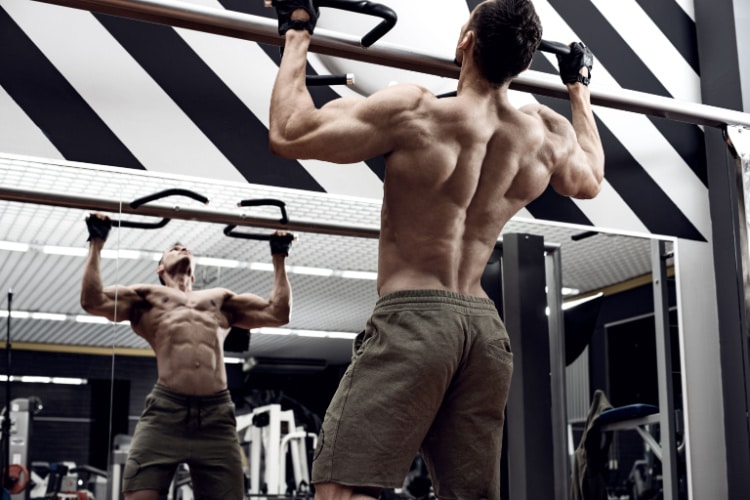
Movement Category: Primary
Programming: 3 to 4 sets of 5 to 8 repetitions
Weight: Use a weight that leaves you 2 to 3 repetitions short of failure, e.g. RPE 7 to 8.
To do chin-ups:
- Stand in front of a pull-up bar, reach up, and take an underhand grip, hands placed shoulder-width apart. Lift your feet off the ground by bending your knees or hanging from an elevated pull-up bar. This is your starting position.
- Take a deep breath and pull yourself up using your upper arms, aiming to pull the bar towards your upper chest until your chin is above the bar.
- Lower yourself back down slowly with as much control as possible.
- After holding at the lowest point of the range of motion for a second, repeat the motion and lift yourself back up to the starting position.
3. Seated Cable Row
The seated cable row is a compound movement that mainly works the latissimus dorsi, rhomboids, trapezius, and biceps brachii. While the lats and rhomboids work as the primary movers, the trapezius and biceps assist the movement. This exercise offers a lot of versatility in terms of the equipment that can be used to do it. For example, while it is mainly done on a seated cable machine, it can also be replicated with a chest-supported row machine, resistance bands, or similar.
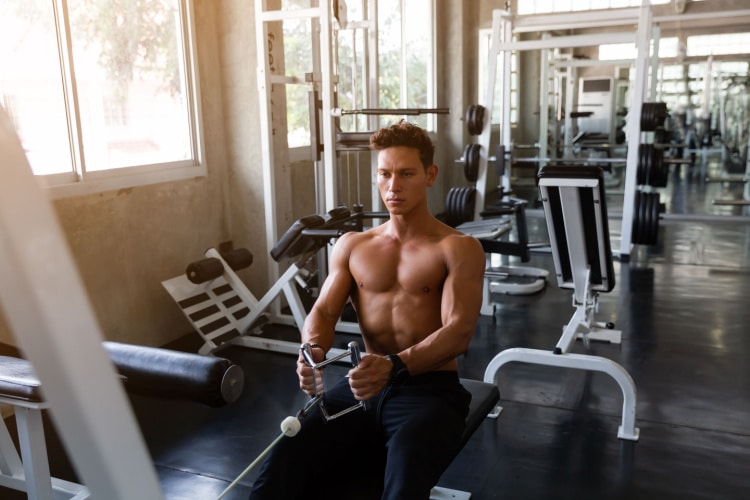
Movement Category: Secondary
Programming: 2-4 sets of 6-10 repetitions
Weight: Use a weight that leaves you 2 to 3 repetitions short of failure, e.g. RPE 7 to 8.
To do a seated cable row:
- Attach a V-grip or similar attachment to the low pulley. Select the appropriate weights on the stack.
- Sitting towards the middle of the bench with your feet planted on the footplate and knees bent, bend at the waist, and grab the handle with a neutral grip.
- While grabbing the handle, lean back until your torso is vertical. Keep a slight bend in your knees. This is your starting position.
- Keeping your back straight and mostly still, pull the bar towards your torso until it almost touches your stomach. Your shoulders should be pulled back and your chest should be extended up.
- Let your arms stretch back to the starting position slowly and with as much control as possible. The key here is not to let the cable pull the bar back but rather to have your arms play an active role in the movement.
4. Lat Pulldown
As the name suggests, the main muscle targeted in lat pull-downs is the latissimus dorsi. However, this compound exercise is excellent for activating not only the lats but also the teres major and minor, posterior deltoid, rhomboids, and trapezius muscles in the back, along with the biceps brachii in the arms.
Research suggests that although not very dramatic, the grip width in a lat pull-down could result in some small differences in muscle development. [3]While results will be similar in most cases, a medium grip, e.g. one that is just wider than shoulder-width is our standard recommendation.
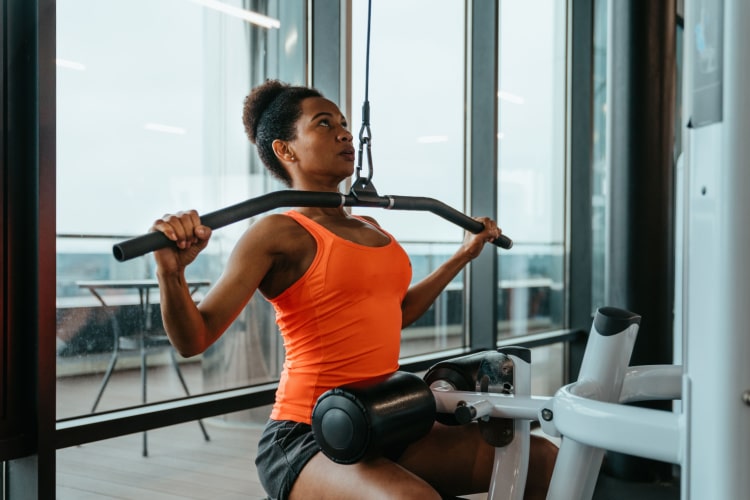
Movement Category: Secondary
Programming: 2-4 sets of 8 to 12 repetitions
Weight: Use a weight that leaves you 2 to 3 repetitions short of failure, e.g. RPE 7 to 8.
To do a lat pull down:
- Set the bar to a height that is comfortable to reach when seated.
- Sit on the pulldown machine seat with your feet flat on the ground.
- Grasp the bar with an overhand grip that is 1-2 hand-widths wider than shoulder-width apart. This is your starting position.
- Take a deep breath and brace your trunk, then pull the bar down towards your upper chest, aiming to pull the bar near the top of your sternum. Ensure your core is tight and your feet are still planted on the floor throughout the range of motion. Try to keep your back as straight and your torso as stable as possible.
- At the lowest point of the range of motion, squeeze your shoulder blades together and hold for a second.
- Release your arms back to the starting position slowly, with as much control as possible.
5. Bent Over Dumbbell Flye
Many of the most popular upper body exercises that involve the shoulders typically activate the anterior deltoids. So, as important as they are, the posterior deltoids are often neglected. However, training the back of our shoulders is just as important as training the front for achieving maximum strength. Not to mention that if you’d like to grow your shoulders, you’ll likely want to train all of the heads of the deltoid.
The bent-over dumbbell flye, also known as the bent-over rear flye, is an isolation movement that targets the posterior deltoid muscles. It also engages other upper back muscles like the trapezius, teres major and minor, and others/ This makes it an efficient exercise to train the posterior shoulder girdle.
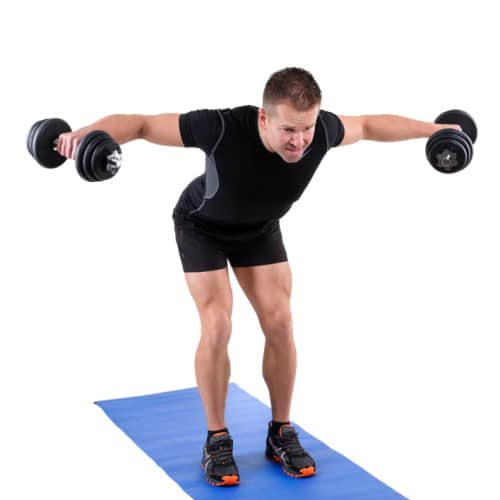
Movement Category: Tertiary
Programming: 2 to 4 sets of 10 to 15 repetitions
Weight: Use a weight that leaves you 1 to 2 repetitions short of failure, e.g. RPE 8 to 9.
To do a bent-over dumbbell flye:
- Make sure you have enough space to complete the full range of motion.
- Grab your dumbbells, your palms facing each other with a neutral grip, keeping them at the sides of your hips.
- Stand with feet hip-width apart and hinge at the hips until your torso is almost parallel to the floor.
- Let your arms hang straight down, still holding onto the dumbbells with a neutral grip. This is your starting position.
- Take a deep breath and lift the dumbbells up and backward in a large arcing motion without bending your elbows until the arms are parallel to your torso.
- Slowly lower the dumbbells back down to starting position, with as much control as possible.
6. Preacher Curl
The preacher curl is an isolation (single joint) exercise for the biceps that uses a bench to create flexion of the shoulder, which lengthens the long head of the biceps, thereby training it at a longer length. [4] Training at longer muscle lengths through a large range of motion is likely to produce more muscle growth compared to only training at shorter lengths, especially for the long head of the biceps.
Like other exercises, loading should be done according to your current fitness level, the rep scheme, and personal needs. So while the preacher curl could be a good exercise to challenge yourself, it’s important to pick the appropriate weight and progressively load it over time.
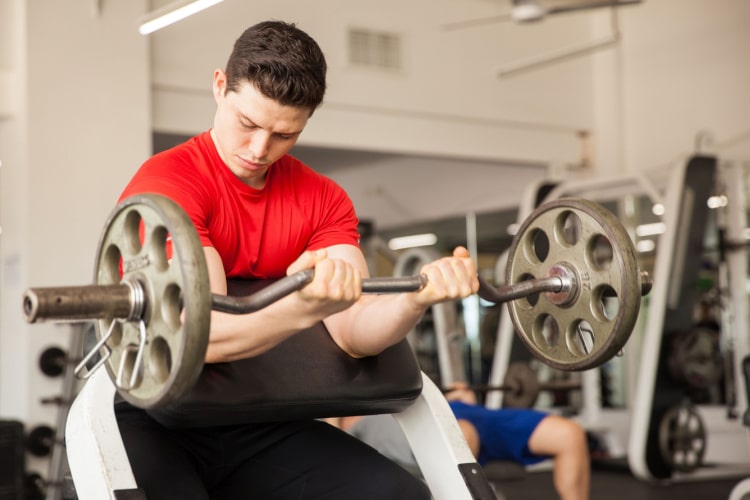
Movement Category: Tertiary
Programming: 3 to 5 sets of 8 to 12 repetitions
Weight: Use a weight that leaves you 1 to 2 repetitions short of failure, e.g. RPE 8 to 9.
To do a preacher curl:
- Grab onto the EZ-curl barbell with an underhand grip. Your gym may have a preacher curl machine, which works just as well.
- Sit down on the preacher curl bench with your feet flat on the ground. The backside of your arms (triceps) and elbows should be in contact with the angled top of the pad, whereas your chest should be butted up against the vertical back portion of the pad. If they aren’t, adjust your seat and positioning accordingly.
- The starting position of the movement is with your arms stretched out with a slight bend in your elbows.
- From here, keep elbows resting on the arm pad and lift the weight upwards and back towards your chest until your elbow is completely bent.
- Squeeze your biceps at the top of the movement.
- Slowly lower and straighten out your arm by letting your elbows bend back to the starting position.
7. Concentration Curl
The concentration curl is one of the best biceps variations for muscular hypertrophy, as it allows the use of a relatively long range of motion with minimal involvement of other muscle groups such as the shoulder.
The key to success with concentration curls is to go through the range of motion slowly and to focus on squeezing the biceps. Paying attention to a deliberate contraction of the biceps will allow trainees to successfully target the whole of the biceps brachii.
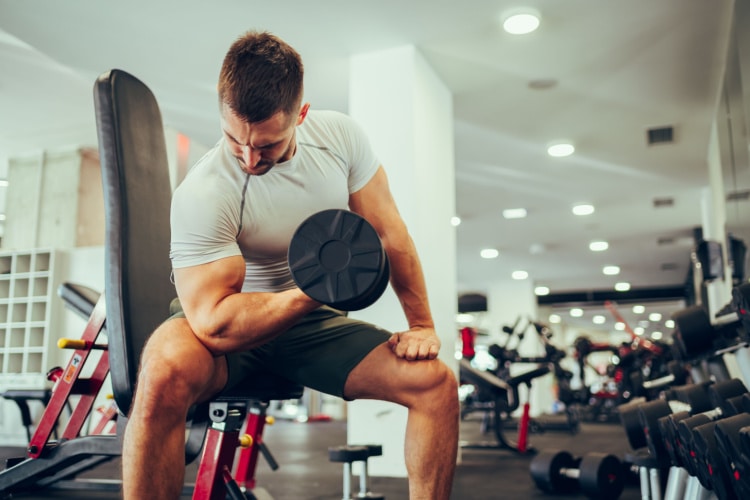
Movement Category: Tertiary
Programming: 3-5 sets of 10 to 15 repetitions
Weight: Use a weight that leaves you 1 to 2 repetitions short of failure, e.g. RPE 8 to 9.
To do a concentration curl:
- Sit on a bench with a dumbbell placed on the ground between your feet.
- Grab onto the dumbbell with one hand and place your upper arm on your thigh. Lift your hand off the ground slightly and turn the dumbbell over to hold it with an underhand grip. Your free hand should be resting on your other leg or hanging freely. This is your starting position.
- Keep your core tight and stable as you curl the weight upwards. Your upper body and shoulders should remain still throughout the movement.
- Slowly reverse the motion and lower the weight back down to the starting position.
- Your arm should stay mostly vertical throughout the range of motion.
There you have it— our go-to pull-day routine. Following this workout will allow you to effectively target your pull muscles in a single day.
If you’d like to add some variation to this workout, it would be completely fine to switch some of the exercises out for others, as long as the exercises target the same muscles and belong to the same movement category. That said, we’d recommend keeping exercises, rep ranges, and volume (total number of sets and reps per week) the same for ~4-to-8 weeks to see how you respond. Based on your results, movement and/or preferences, and goals, you can change things up periodically.
For a typical pull day, we recommend starting with six total exercises, e.g. three compound exercises and one isolation movement for the muscles of the back, and two additional isolation exercises for the biceps.
We also advise trainees to begin their workouts with compound movements and gradually move on to isolation movements. The general rule of thumb would be to start with the exercise targeting the highest number of muscles or the largest area on the body and finish off with the exercise targeting the smallest areas.
However, maximum results aren’t achieved through exercise alone. Building strength and muscle requires more than just regular trips to the gym, e.g. proper nutrition is crucial to getting the most out of your training. In the following section, we’ll let you in on some key tips on how to supplement your training by eating right.
Pull Day Nutrition & Supplements
While your daily nutritional intake depends on various factors, such as your current body composition and your fitness goals, we want to share some guidelines related to three of the key components of any diet plan: proteins, carbohydrates, and nutritional supplements.
Why is Protein Important?
Resistance training increases the rates of both the synthesis and breakdown of muscle proteins. For an increase in muscle size, the synthesis of muscle proteins must exceed the breakdown. Muscle protein synthesis is an anabolic (tissue-building) reaction to two primary inputs: 1) dietary protein and 2) resistance exercise. When a high-protein meal is consumed, muscle protein synthesis rates rise for a few hours before reverting to baseline. [5]
Before or after exercise, consuming proteins increases the synthesis of proteins in the muscles and enhances the body’s overall protein balance. [6]
The effects of protein ingestion were examined in a 2015 study where two subject groups; one consuming a high-protein diet and the other consuming a diet with average levels of protein participated in resistance training. Significant changes in body composition were observed in the group eating the high-protein diet, including weight loss, reduced fat mass, and body fat percentage, as well as greater increases in muscle mass compared to those eating a normal protein diet. [7]
Additionally, a meta-analysis of 89 articles studying the effects of protein consumption on individuals undergoing resistance training revealed that combining resistance training with supplemental protein consumption provides individuals with dose-dependent improvements in strength and size if their protein intake would otherwise be low. [8]
Recommendations for Protein Intake
Unless there is a special medical need to consume less, the average person’s daily protein consumption should be ~1.6 grams of protein per kilogram of total body weight per day. People who are actively losing weight and/or have anabolic resistance risk factors may benefit from a slightly higher intake. [9] Similarly, competitive physique athletes, e.g. bodybuilders, and/or those who are training multiple hours per day 4+ days per week may benefit from increasing protein consumption to between 2.2 to 3.1 grams of protein per kilogram of body weight per day.
At this level of protein intake, the sources of protein are plants (such as soy, lentils, etc.) or animals (such as fish or eggs) matters only a little to strength and muscle size. The dose of protein is high enough to make up for differences in protein efficiency.
On the other hand, if you’re on a protein-restriction diet, e.g. consuming <1 gram of protein per kilogram body weight per day, there may be advantages for training adaptations to consuming more protein from animal sources. [10]
Eating the appropriate amount of proteins is key, but there are some additional measures you could take to get the most out of your diet regarding meal frequency and timing. We recommend eating 3 to 5 times per day, 3 to 5 hours apart, and including protein at each meal. [11]
Why Are Carbohydrates Important?
For most individuals, carbohydrates represent nearly half of the Calories consumed daily. This makes them a critical component of life and exercise, particularly resistance training [12] However, there’s not a clear link between higher or lower levels of carbohydrate intake and strength performance, according to a meta-analysis of 49 studies. [13] On the flip side, several of these trials were short, uncontrolled in terms of actual nutrition intake (and differences between groups), used untrained subjects, and had relatively low training volumes. It’s possible that consuming “lower” levels of carbohydrates, which is poorly defined in the literature, doesn’t make much of a difference unless the training volume is fairly high, the lifter is advanced, and/or carbohydrate intake is truly low.
While interesting, this study does not mean that carbohydrate intake is irrelevant to training performance. In fact, consuming adequate amounts of carbohydrates is important in certain situations, so bear with us as we get into the science:
Reduced levels of stored glucose (glycogen) in the liver and muscle can reduce performance during exercise if they’re low enough, as the amount of energy available is reduced. [14, 15] Reduced muscle glycogen levels also alter the flow of calcium, a chemical element necessary for muscle contraction, thus potentially altering muscular force production. [16, 17]
Muscle glycogen levels below ~70 mmol/kg are assumed to indicate a threshold where muscular force generation diminishes, contributing to tiredness and restricting performance. [18] This shows that there is a threshold for decreased muscle glycogen stores impacting performance, although a smaller decline may have little to no effect.
This phenomenon, glycogen depletion, is one of many that can contribute to fatigue during prolonged exercise or exercise that’s performed fasted. [19] While most don’t require carbohydrate supplements to perform their best, a person who would otherwise train fasted and/or who is engaging in long (>90-minute), high-volume training sessions, may benefit from consuming supplemental carbohydrates before and during a workout for maximal performance. [20]
Recommendations for Carbohydrate Intake
We recommend most folks consume about 3 to 5 grams of carbohydrates per kilogram of body weight per day unless you are training for multiple hours per day. [21] Food-wise, we recommend getting most of your carbohydrates from whole grains, fruits, vegetables, and legumes, and limiting processed foods with added sugars. For those who would benefit from consuming carbohydrates during a workout, we recommend starting with 20 to 30 grams of carbohydrates per hour and adjusting from there based on an individual’s tolerance.
Keep in mind that low carbohydrate intake may negatively impact muscle gains and improvements in endurance-related performance. This is especially true for well-trained individuals. [22, 23][3] [4] [5] [6] [7] [8]
So, we’ve covered the two most important components of diet planning for pull days. However, there’s still an extra mile you could go if you’d like to maximize your results. Next up, we’ll explore some nutritional supplements you could take to amplify your results.
Supplements
As popular as supplements are, it’s often difficult to find reliable information about them. We must underline that it’s absolutely not necessary to take supplements, and it should be more of a personal choice. However, there aren’t too many benefits to taking nutritional supplements. For example, taking vitamin D, fish oil, or multivitamins, does not appear to be useful for most individuals in terms of lowering the risk of heart disease or some forms of cancer. [24, 25, 26][9] [10] [11] [12] [13] [14]
The following is a selection of vitamins from our shop that we stand behind and recommend to those who are undergoing resistance training:
- Peri-RX with Caffeine: To maximize performance, our Peri-RX supplement — which contains caffeine — is meant to be taken before exercise. But we also have non-caffeinated versions of this product, such as Peri-RX Watermelon, for those who are particularly sensitive to caffeine.
- Whey Protein Isolate—Vanilla: Although there are several varieties of protein supplements on the market, whey protein is digested more rapidly than other varieties, which may help build muscle quicker. Not a vanilla fan? No problem! We also offer a chocolate-flavored variation we’re sure you’ll love.
Making the right dietary choices is crucial for achieving the goals you desire. Protein and carbohydrate intake should be planned carefully, and you could additionally take supplements to enhance your performance and gains. Paired with the right workout plan, the appropriate diet plan and supplements can help you go the extra mile.
Tips to Improve Your Pull Day Workout
Following your workout regimen to a T is essential for attaining your desired results, but there are a few key things that trainees often miss simply because they don’t know about them. Here’s what you need to keep in mind.
Progressive Loading Is Key
This is a tip that applies to all forms of resistance training in general. Progressive loading refers to gradually increasing the load used in exercise to keep pace with an individual’s improvement in fitness. In other words, as you get stronger, better conditioned, and so on, your training needs to match these improvements by increasing the weight lifted, reps completed, and so on. Without progressive loading, the training is unlikely to drive continued improvements in fitness. hit a plateau.
How you implement progressive loading into your program will mostly depend on the goals and setup of the program, as well as how you’re responding. Strength improvements take place over time, typically weeks, which should coincide with a weight and/or rep increase. The key here is to autoregulate and be aware of your personal needs. A good way to know when you can go up a couple of pounds would be to measure your RPE periodically and make adjustments once it gets too easy to lift your current weights.
Control Your Eccentric Phases
In a typical resistance training exercise, there are three phases of movement; the concentric phase, the isometric phase, and the eccentric phase.
The concentric phase occurs when the muscle shortens as it contracts. A good example of this would be the lift in a biceps curl, as the upward motion would be the concentric phase. The next phase would be the isometric phase, in which the muscle is contracting but not changing in length- think the bottom of a squat between the up and down phases. Finally, the eccentric phase is when the muscle contracts as it lengthens, e.g. the downward phase of a biceps curl where you lower the barbell or dumbbell down to the starting position.
Overall, controlling the eccentric phase is important for strength and hypertrophy. [27, 28]
How to Avoid Injuries in a Pull Day
If done properly, resistance training may be very helpful to our health; yet, if safety precautions are not taken, it can also be dangerous. The following guidelines should be followed to ensure that you are exercising safely:
- Practice proper technique: There are specific points of performance for each exercise, e.g. range of motion, tempo, posture, etc. These eventually result in a wide range of acceptable techniques for trainees. As long as the exercise is performed repeatedly with an efficient movement pattern, and as long as it satisfies the points of performance points required for that particular exercise, your unique technique will work just fine. We advise against limiting yourself to a particular movement pattern, as techniques vary over time.
- Use well-maintained equipment:
Most gym accidents are due to faulty equipment, not trainees doing the exercise wrong. So — double-check your equipment to make sure it’s well-maintained and working correctly before beginning to exercise. If you’re not sure whether it’s working correctly, ask gym staff to check in your stead.
- Avoid overdoing it: A good workout program should make you feel the burn, but it’s not supposed to make you feel chronically sore or fatigued. If it does, you might be training with an excessive load. Autoregulate to make sure you’re working with the right weights and following the right program.
- Reach out to professionals: Still got questions on how to train safely or perfect your technique? Reach out to us. Our coaching team, made up of qualified physicians and personal trainers, will give you the right tools to train safely and efficiently to ultimately achieve your goals… and discover some other merits along the way.
How to Track Your Progress
At the end of the day, we’re all here for the same thing — results. But our perception may be misleading. At times, we may think the progress is dramatic but sometimes it may just not seem like it’s enough. So, how do we sort through the noise and see for sure if we’re progressing? Well, there are a few strategies that can help us out with our progress tracking. Let’s check out a few.
Fitness Journaling
This is actually what your trainer does to keep track of your progress. Who says you can’t do it too? In fact, you could probably do a great job of it because you’d know more about your daily habits than anyone else. Keep track of your weights lifted, completed reps, RPE, and conditioning performed to monitor your progress.
Frequently Asked Questions
We’ll finish this article off with some common questions about pull days asked by fitness enthusiasts.
How Many Pull Day Exercises Is Enough?
The number of pull-day exercises will rely on a few key factors: intensity, frequency, and volume. You can read about each component in detail in our How Many Chest Exercises Per Workout article, but to give you a brief overview:
- Intensity refers to the weight used for an exercise.
- Volume refers to the number of repetitions performed for a muscle group or movement in a given time — usually measured by a single workout or full training week.
- Frequency refers to how many muscle or muscle group types are trained within a week.
Our pull-day programming recommendations are:
- Exercise selection — For newer lifters, select 1 to 2 compound (multi-joint) exercises for the back, one primary and one secondary. Then, choose 1 isolation exercise for the back or posterior shoulder girdle and 1-2 isolation exercises for the biceps. For more advanced lifters, we’d select 3 to 4 compound and 1 to 2 isolation exercises for the back, along with 2 isolation exercises for the biceps.
- Volume — Complete 2 to 3 sets of each exercise for the rep ranges described in the exercise recommendation section. We recommend ~ 6 to 10 sets per week for the muscles of the back and for the biceps for newer lifters, though advanced lifters may need double this amount of volume.
- Intensity —Use a weight that gets you within ~1 to 3 repetitions of failure for each set at the designated rep range, e.g. RPE 7 to 9 for both newer and experienced trainees alike.
- Frequency —Using a pull day as part of a push-pull-legs (PPL) training split will typically result in training these muscles once or twice per week.
Regardless of where you’re at in your fitness journey, the key here is to target all of your pull muscles within the same workout using this training split.
How Long Will It Take to See Results?
It is a widely accepted idea that resistance training will result in muscle strength gains. Most studies will first assess the average strength of the resistance training test group, and then assess how individuals respond in comparison to the average. In most research, respondents’ average strength rises; however, this growth is not uniform and varies widely from person to person. There may be non-responders, who don’t show any muscular development throughout the training, “extreme” responders who show elevated amounts of muscular development, and those who fall somewhere in between.
The rates of strength gains also show variety. A recent analysis of 40 resistance training studies that measured progress throughout the training program (not just before and after) revealed that it took an average of 4.3 weeks to see any significant gains. Improvements in strength could be recorded after anywhere between 1-to-12 weeks. The total percentage of improvements in strength also varied, ranging from 3% to 40% for squat 1RM strength tests. [29]
Another factor that leads to the non-uniformity of responses would be the internal and external factors that affect an individual during a training session These could be variables such as mood, energy levels, motivation, action type, strategy, and others.
References:
- Tjøsvoll, S. O., Mork, P. J., Iversen, V. M., Rise, M. B., & Fimland, M. S. (2020). Periodized resistance training for persistent non-specific low back pain: a mixed methods feasibility study. BMC sports science, medicine & rehabilitation, 12, 30. https://doi.org/10.1186/s13102-020-00181-0
- Schoenfeld, B. J., Ogborn, D., & Krieger, J. W. (2016). Effects of Resistance Training Frequency on Measures of Muscle Hypertrophy: A Systematic Review and Meta-Analysis. Sports medicine (Auckland, N.Z.), 46(11), 1689–1697. https://doi.org/10.1007/s40279-016-0543-8
- Andersen, V., Fimland, M. S., Wiik, E., Skoglund, A., & Saeterbakken, A. H. (2014). Effects of grip width on muscle strength and activation in the lat pull-down. Journal of strength and conditioning research, 28(4), 1135–1142. https://doi.org/10.1097/JSC.0000000000000232
- Oliveira, L. F., Matta, T. T., Alves, D. S., Garcia, M. A., & Vieira, T. M. (2009). Effect of the shoulder position on the biceps brachii EMG in different dumbbell curls. Journal of sports science & medicine, 8(1), 24–29.
- Atherton, P. J., & Smith, K. (2012). Muscle protein synthesis in response to nutrition and exercise. The Journal of physiology, 590(5), 1049–1057. https://doi.org/10.1113/jphysiol.2011.225003
- Kerksick, C. M., & Leutholtz, B. (2005). Nutrient administration and resistance training. Journal of the International Society of Sports Nutrition, 2(1), 50–67. https://doi.org/10.1186/1550-2783-2-1-50
- Antonio, J., Ellerbroek, A., Silver, T., Orris, S., Scheiner, M., Gonzalez, A., & Peacock, C. A. (2015). A high protein diet (3.4 g/kg/d) combined with a heavy resistance training program improves body composition in healthy trained men and women–a follow-up investigation. Journal of the International Society of Sports Nutrition, 12, 39. https://doi.org/10.1186/s12970-015-0100-0
- Morton, R. W., Murphy, K. T., McKellar, S. R., Schoenfeld, B. J., Henselmans, M., Helms, E., Aragon, A. A., Devries, M. C., Banfield, L., Krieger, J. W., & Phillips, S. M. (2018). A systematic review, meta-analysis and meta-regression of the effect of protein supplementation on resistance training-induced gains in muscle mass and strength in healthy adults. British journal of sports medicine, 52(6), 376–384. https://doi.org/10.1136/bjsports-2017-097608
- Stokes, T., Hector, A. J., Morton, R. W., McGlory, C., & Phillips, S. M. (2018). Recent Perspectives Regarding the Role of Dietary Protein for the Promotion of Muscle Hypertrophy with Resistance Exercise Training. Nutrients, 10(2), 180. https://doi.org/10.3390/nu10020180
- Stokes, T., Hector, A. J., Morton, R. W., McGlory, C., & Phillips, S. M. (2018). Recent Perspectives Regarding the Role of Dietary Protein for the Promotion of Muscle Hypertrophy with Resistance Exercise Training. Nutrients, 10(2), 180. https://doi.org/10.3390/nu10020180
- Chourpiliadis C, Mohiuddin SS. Biochemistry, Gluconeogenesis. [Updated 2023 Jun 5]. In: StatPearls [Internet]. Treasure Island (FL): StatPearls Publishing; 2023 Jan-. Available from: https://www.ncbi.nlm.nih.gov/books/NBK544346/
- Haff, G. G., Lehmkuhl, M. J., McCoy, L. B., & Stone, M. H. (2003). Carbohydrate supplementation and resistance training. Journal of strength and conditioning research, 17(1), 187–196. https://doi.org/10.1519/1533-4287(2003)017<0187:csart>2.0.co;2
- Sahlin K. (2014). Muscle energetics during explosive activities and potential effects of nutrition and training. Sports medicine (Auckland, N.Z.), 44 Suppl 2(Suppl 2), S167–S173. https://doi.org/10.1007/s40279-014-0256-9
- Mul, J. D., Stanford, K. I., Hirshman, M. F., & Goodyear, L. J. (2015). Exercise and Regulation of Carbohydrate Metabolism. Progress in molecular biology and translational science, 135, 17–37. https://doi.org/10.1016/bs.pmbts.2015.07.020
- Gejl, K. D., Hvid, L. G., Frandsen, U., Jensen, K., Sahlin, K., & Ørtenblad, N. (2014). Muscle glycogen content modifies SR Ca2+ release rate in elite endurance athletes. Medicine and science in sports and exercise, 46(3), 496–505. https://doi.org/10.1249/MSS.0000000000000132
- Nielsen, J., Holmberg, H. C., Schrøder, H. D., Saltin, B., & Ortenblad, N. (2011). Human skeletal muscle glycogen utilization in exhaustive exercise: role of subcellular localization and fibre type. The Journal of physiology, 589(Pt 11), 2871–2885. https://doi.org/10.1113/jphysiol.2010.204487
- Murray, B., & Rosenbloom, C. (2018). Fundamentals of glycogen metabolism for coaches and athletes. Nutrition reviews, 76(4), 243–259. https://doi.org/10.1093/nutrit/nuy001
- [Henselmans, M., Bjørnsen, T., Hedderman, R., & Vårvik, F. T. (2022). The Effect of Carbohydrate Intake on Strength and Resistance Training Performance: A Systematic Review. Nutrients, 14(4), 856. MDPI AG. Retrieved from http://dx.doi.org/10.3390/nu14040856
- Haff, G. G., Lehmkuhl, M. J., McCoy, L. B., & Stone, M. H. (2003). Carbohydrate supplementation and resistance training. Journal of strength and conditioning research, 17(1), 187–196. https://doi.org/10.1519/1533-4287(2003)017<0187:csart>2.0.co;2
- Kantor, Elizabeth D et al. “Trends in Dietary Supplement Use Among US Adults From 1999-2012.” JAMA vol. 316,14 (2016): 1464-1474. doi:10.1001/jama.2016.14403
- Kerksick, C. M., Wilborn, C. D., Roberts, M. D., Smith-Ryan, A., Kleiner, S. M., Jäger, R., … Kreider, R. B. (2018). ISSN exercise & sports nutrition review update: research & recommendations. *Journal of the International Society of Sports Nutrition, 15*(1), 38. https://doi.org/10.1186/s12970-018-0242-y
- Burke, Louise M et al. “Low carbohydrate, high fat diet impairs exercise economy and negates the performance benefit from intensified training in elite race walkers.” The Journal of physiology vol. 595,9 (2017): 2785-2807. doi:10.1113/JP273230
- Paoli, Antonio et al. “Ketogenic Diet and Skeletal Muscle Hypertrophy: A Frenemy Relationship?.” Journal of human kinetics vol. 68 233-247. 21 Aug. 2019, doi:10.2478/hukin-2019-0071
- Barbarawi, Mahmoud et al. “Vitamin D Supplementation and Cardiovascular Disease Risks in More Than 83 000 Individuals in 21 Randomized Clinical Trials: A Meta-analysis.” JAMA cardiology vol. 4,8 (2019): 765-776. doi:10.1001/jamacardio.2019.1870
- Siscovick, David S et al. “Omega-3 Polyunsaturated Fatty Acid (Fish Oil) Supplementation and the Prevention of Clinical Cardiovascular Disease: A Science Advisory From the American Heart Association.” Circulation vol. 135,15 (2017): e867-e884. doi:10.1161/CIR.0000000000000482
- O’Connor EA, Evans CV, Ivlev I, et al. Vitamin and Mineral Supplements for the Primary Prevention of Cardiovascular Disease and Cancer: Updated Evidence Report and Systematic Review for the US Preventive Services Task Force. JAMA. 2022;327(23):2334–2347. doi:10.1001/jama.2021.15650
- Coratella, G., Beato, M., Bertinato, L., Milanese, C., Venturelli, M., & Schena, F. (2022). Including the Eccentric Phase in Resistance Training to Counteract the Effects of Detraining in Women: A Randomized Controlled Trial. Journal of strength and conditioning research, 36(11), 3023–3031. https://doi.org/10.1519/JSC.0000000000004039
- Hughes, D. C., Ellefsen, S., & Baar, K. (2018). Adaptations to Endurance and Strength Training. Cold Spring Harbor perspectives in medicine, 8(6), a029769. https://doi.org/10.1101/cshperspect.a029769
- Lambrianides, Yiannis; Epro, Gaspar; Smith, Kenton; Mileva, Katya N.; James, Darren; Karamanidis, Kiros. Impact of Different Mechanical and Metabolic Stimuli on the Temporal Dynamics of Muscle Strength Adaptation. Journal of Strength and Conditioning Research 36(11):p 3246-3255, November 2022. | DOI: 10.1519/JSC.0000000000004300